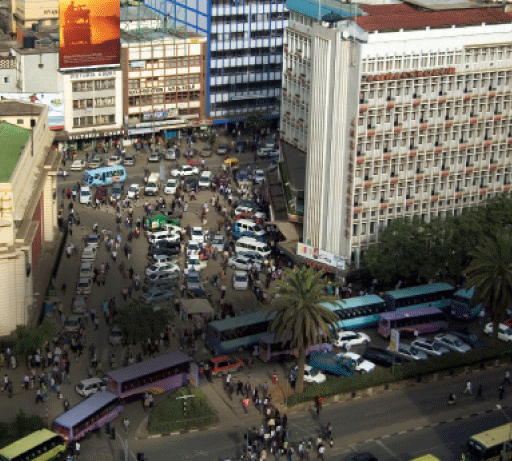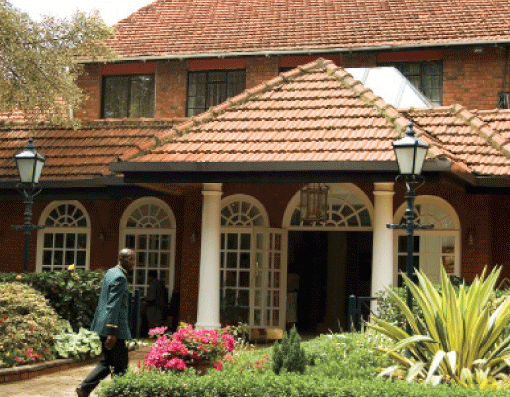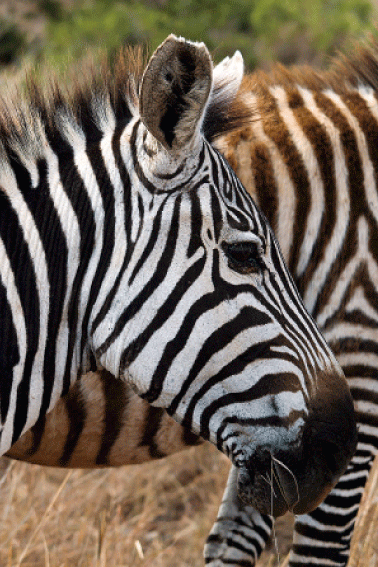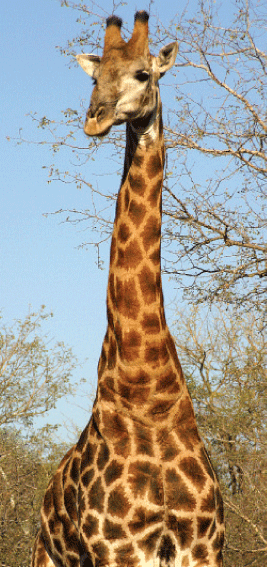
NAIROBI
GATEWAY TO THE RIFT VALLEY
 |
At an elevation of almost 2,000 metres above sea level Nairobi enjoys a comfortable climate
and all year round it is never too hot. The centre is compact so you can easily explore by walking around downtown. Surrounding the centre are the affluent suburbs of Westlands, Gigiri, Muthaiga, Karen, Parklands and Langata.
And it is easy to get things done speedily and efficiently in the city.It is easy-going, tolerant place too.
There is a large expatriate population and everyone, it seems, comes from somewhere else.
Written & Photographs by: Veronica Maria Garbutt
Nairobi is the capital of Kenya and the largest urban centre in East Africa. A city of surprises, it is where matatus, mokeni (handcarts) and Masai mingle with smart office workers, students and food stall vendors. The complete spectrum of society can be seen on the invariably busy streets. And the outskirts are home to a National Park with zebras, buffalo and giraffes. 
The name Nairobi comes from the Masai word enairobe, which literally means " stream of cold water. " This cool city also boasts some of the region's best hotels, shops and restaurants. Plus it the gateway to the Great Rift Valley, the Central Highlands, Tsavo National Park and Mombasa, Malindi, and Lamu along the coast. In Lamu the Arab influence can be seen, and the relaxed pace means that it is a great place to unwind.
During 1896 CE Nairobi was a railway camp and depot during the construction of the East Africa Railway. Many Indian labourers came over to work on the line. The city was founded in 1899 CE and by 1907 CE it had become the regional capital. Fertile land around the city attracted European farmers and settlers, among them Karen Blixen of Out of Africa fame. Upon independence on 12 December 1963 CE it became the Kenyan capital and is now home to over 1.5 million people, many from the Kiyuku, Luo and Masai tribes.
The city centre is compact, bounded by University Way, Haile Selassie Avenue, Uhuru Highway and tom Mboya street. It bustles with offices, shops and public buildings – the older ones are Asian-influenced, the government buildings show Victorian British influence and the latest ones are glass skyscrapers. Just south of the railway station and a few blocks east lie the bus stations.
If you are interested in history be sure to drop by the Norfolk Hotel for tea on the terrace. It was the city's first hotel built in 1904 CE on Harry Thukuru Road for new arrivals. It remained an important meeting place for businessmen, travellers and settlers from all over. Nearby is the University of Nairobi and the Safari Club, a good dining and music spot. These days it is bustling with Kenyans rather than the old colonials of yore.
A good place to start exploring downtown is the Thorn Tree Café at the Stanley hotel. Another popular meeting place for visitors and locals alike, the café has an acacia tree as a centerpiece. In the past travellers would pin notices there and it became an African icon. These days people prefer the internet café!
The grandest and greenest part of town is undoubtedly City Square. This area is home to government buildings, banks, offices of multinationals and luxury hotels. Its landmarks are the tall cylindrical tower of Kenyatta Conference Centre, the Nation Centre and the blue glass tower of the Lonhro Centre. For a small fee you can ascend to the 28th floor of the KCC for an amazing view and photos. Heading north up Mbingue Avenue you will arrive at the City Market. Here the usual ...and some unusual…fruit and vegetables are on sale along with baskets, carvings, jewellery, Masai beadwork and drums.
Opposite is Jamia Masjid with its distinctive green and white façade and twin minarets. It is there for the performance of salat by the Ummah and has a capacity of 2,000 worshippers. Also onsite is a library along with information, welfare and educational services.
Heading north some three blocks you will come to Jeevanjee Gardens, a refreshing place to pause amid the greenery. Just outside the park at the intersection of Monrovia Street and Moi Avenue a Masai Market is held on
Tuesday and Friday mornings.
Next up is the Kenya National Museum. Located on Museum Hill off Chiromo Road, the collection showcases Kenya's history including natural history and culture. There are displays of fossils, rock art, the origin of humans and a bird gallery. An ethnography section focuses on the culture of Kenyan tribes. For me the highlights were viewing The Peoples of Kenya by Joy Adamson, followed by a stroll in the cool, shady arboretum adjacent. This is home to many birds, monkeys and butterflies.
Arts aficionados should be sure to visit the Mzizi Arts Centre in Nairobi Arts Centre on James Gichuru Road in Lavington. Here you can enjoy Kenyan painting, crafts and performance art. The Kenyan National Theatre on Harry Thunku road opposite the Norfolk hotel showcases local playwrights. And the Professional Centre on Parliament Road is the home of the Phoenix Players. Back Downtown the National Archives is a must. Along with the usual documents I found the historic photos and models of different tribal homes outstanding.
Beyond lies River Road which is worth a wander in. It is lively, colourful, crowded and full of character and has the authentic vibe of the African district of a great city. Here you can stop for a fruit juice or a glass of chai, visit the barbers, buy fabrics, have a manicure or just imbibe the atmosphere. A great crossing place, it appears that all the matatus plus intercity and international buses emanate from here.
Heading down towards the train station you can visit the Railway Museum en route. It is a must for steam train buffs and has locomotives and rolling stock from what was the East Africa Railways and Harbour Corporation. Photos depict the stations, personnel and the feats required to get the trains up and down escarpments.
At the railway station proper you can book tickets to and from Mombasa. Trains run three times a week in each direction and depart at 1800 arriving the next morning around 1000. Tickets cost approximately US$60 one way in comfortable first class. And prices include dinner and breakfast with silver service in the buffet car. Dishes such as roast beef with all the trimmings and curry with rice are on offer. And you wake up to spectacular rural scenery and village life en route.
Set aside a whole morning to visit Nairobi National Park located just 10 km south of the capital. Here a steep river valley is African savannah with rhino, zebra, giraffe, ostrich and gazelle roaming and hippos bathing in pools against a backdrop of skyscrapers. At present the park is unfenced so all creatures great and small can migrate freely to the Rift Valley. Close by is the Animal Orphanage, which children particularly will enjoy.
Next head out along eucalyptus-lined streets to the suburb of Karen. Here is located the Karen Blixen Museum, a handsome house with wood panelled walls and period furnishings set on a former coffee plantation. Much of the filming of Out of Africa was done here in the Danish author's home as it gives an interesting insight into the privileged lives of the early settlers. Evocatively written, the book captures the magic of Africa. The house was bought by the Danish government and presented to Kenya as a gift upon independence.
Dining out in Nairobi is an adventure and standards of service are high, owing to the Kenyans' welcoming nature. Lunch is the main meal of the day and be sure to try the local ugali and goat stew, mandanaazi and githeri. Several South African fast food joints such as Nandos (chicken), Debonairs (pizza and salad), and Steers (burgers and ribs) have sprung up. For dinner the city centre offers a cosmopolitan choice, as does the suburb of Westlands, an up-and-coming foodie haunt.
For a buffet of Kenyan dishes check out the Panafrica hotel's Pool Garden. Choose from beef and matake, tilapia fish, sautéed spinach and sweet potatoes plus offal and kachumbari. Ethiopian dishes are served at Addis Ababa in Westlands. Popular with visitors is Carnivore in Langata which offers all you can eat game. Choose from zebra, wildebeest, eland, crocodile and ostrich.
Also in Westlands is Phoenicia which does excellent Lebanese food cooked in a wood-fired oven. For Moroccan head to Café Mahgreb at the Serena hotel. Tamarind on Aga Khan Walk is said to be the best seafood with Swahili influence. Misono does Japanese and China Place serves Szechuan cuisine. If you fancy Indian try Haandi in Westlands Mall and for Italian don't miss IC Casale in..you've guessed…Westlands again.
Top end accommodation can be found at the aforementioned Norfolk hotel where Lord Baden Powell and Theodore Roosevelt have stayed. It remains the favourite with visiting celebrities today. The New Stanley was originally an Edwardian structure and has been renovated and furnished in Art Deco style. It's best feature is the rooftop pool and restaurant.
The cylindrical tower of the Hilton on Mama Ngina Street is a landmark. It offers a heated outdoor pool, health club, jacuzzi, sauna and steambath. Another good option is the Serena hotel, impeccably kitted out in a uniquely African style. Guest rooms feature marble bathrooms, artworks and intricately carved wooden furniture. If your budget does not extend to these luxurious places try The Diplomat or Kenya Comfort hotel.
Golfers might enjoy staying and playing at the Windsor Golf and Country club, just north of the city. Patterned on a Victorian style country house hotel it has an 18-hole golf course on forested terrain. There is also horseback riding along with tennis and squash courts. Other golf courses around Nairobi include the Railway Golf Club, Karen Country club and Muthiaga Golf Club. And as well as horse racing most Sundays, the Jockey club of Kenya at Ngong Racecourse also offers a nine-hole golf course. For all the lowdown on golf visit www.golfinginkenya.com